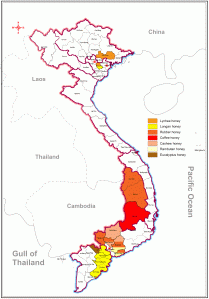Nhờ tổ chức được chương trình kiểm soát chất lượng và các chất tồn dư trong mật ong nên sản phẩm mật ong của Việt Nam rất được ưa chuộng trên thị trường thế giới. Hiện nay, bình quân mỗi năm các doanh nghiệp chế biến và xuất khẩu mật ong Việt Nam xuất được từ 2.000 – 3.000 tấn mật ong sang thị trường EU.

Apiculture (from Latin apis, meaning bee) is the study and practice
of beekeeping. Natural honey is not the only product associated
with this activity. Beeswax, propolis , royal jelly and honeycomb are
all by-products of beekeeping. Beeswax is used in the production of
candles and cosmetics (Harmonisation System (HS) Code for beeswax
is 152190). Due to the high value of especially beeswax, but also the
other by-products, on the international markets it is crucial to recognize
these as important sources of income for beekeepers in Southern
Africa. However, the focus of this TIB will be on natural honey (also
only referred to as honey in this TIB), and the opportunities involved
in the production and exportation of natural honey. The HS Code for
natural honey is 0409. There is no further categorisation of honey and
as a consequence dark and light honey (which have very different price
premiums attached to them) are in terms of trade data considered the
same. Natural honey is utilised in four main ways:
Honey for direct consumption;
Honey as an ingredient in products;
Industrial honey;
Honey as a raw material for mead.
The Codex Alimentarius define honey in the following way:
“Honey is the unfermented, natural sweet substance produced by honeybees
from the nectar of blossoms or from secretions of living parts
of plans or excretions of plant-sucking insects on the living part of the
plants, which honeybees collect, transform and combine with specific
substances of their own, store and leave in the honey comb to ripen
and mature, Honey shall not have any objectionable flavour, aroma or
taint absorbed from foreign matter during its production, harvesting,
processing and storage and shall not contain natural plant toxins in an
amount that may constitute hazard to health” (CBI Market Information
Database).
The origin and the colour of honey are important price determinants.
The quality and origin of the honey is a major factor in price
setting. China supplies the lowest-priced honey, Argentina takes a middle
position and honey from Mexico and Australia receives the highest
prices in international trade (EPOPA 2006). Light honey receives
a higher price due to the fact that the general preference is for clear
Propolis is a substance made by bees from plant resin. It is used for cosmetic, medicine and
food.
■
2. Production description and definition
Hone y
honey with a mild taste. In recent years the monofloral types, such as
Acacia, have become more popular. Furthermore, honey infused with
various flavours, such as ginger, vanilla and cinnamon is becoming increasingly
popular (and is consequently of higher price) (CBI Market
Information Database). Although honey is occasionally infused with
various flavourants, the most common determinant of the flavour is the
flora in the area where the beehives are kept. Depending on the plantation
in the beekeeping area the honey will have different tastes due to
the fact that it is absorbed by the honeybee. In other words, if beekeeping
is practiced in an area with sunflower plantations the output will be
sunflower honey.
Around 300 varieties of flower are suitable as floral sources for
honey, and naturally produced honey reflects the local conditions and
climate in a country. The most common types of honey are:
Acacia: light in taste and has a refined scent. This type of honey
tends not to crystalise. The largest producer of Acacia honey is
China.
Orange blossom: Honey with a refreshing bittersweet flavour. Mexico
and the US are the main producers of Orange blossom honey.
Buckwheat: This honey has a strong smell and tastes similar to
brown sugar. China is the main producer.
Lotus: Honey with a mellow, sweet flavour and a faint smell of flowers.
China is also the largest producer of this type of honey.
Clover: This is the most widely produced and well-known type of
honey. Canada, the US, Argentina and Australia are the main producers
of Clover honey (CBI Market Survey 2005).
Possible lucrative niche markets in terms of honey exportation include
organic honey and fair-trade honey. O rganic honey trade is difficult
to analyse because of the fact that there is not much trade data
available on this, however, it will be included in this TIB due to the potential
this product has for SADC farmers. Another alley worth exploring
for SADC beekeepers is selling their honey on the global markets as
Fair Trade honey. Although the costs of certification are relatively high,
the premium they will receive will be worth it in the long run. As a consequence
of the value-added production linked to export of organic and
fair-trade honey these two niche markets will be further discussed in
chapter 5, while the focus of the rest of the TIB will be on conventional
honey.

